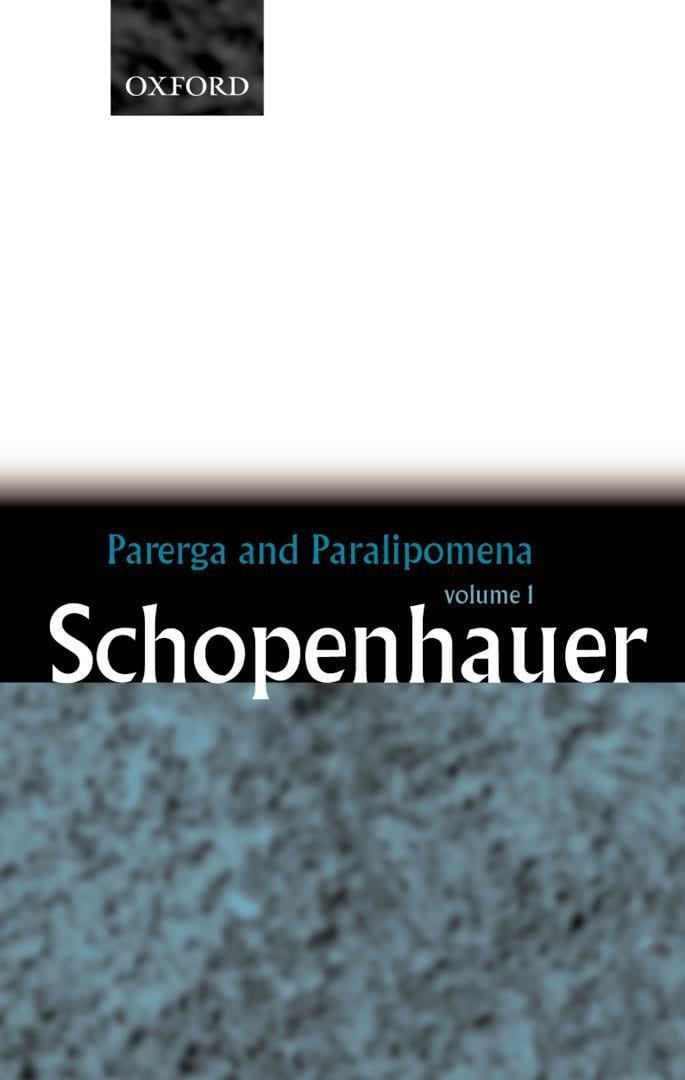8.8 /10 1 Votes8.8
Originally published 1851 | 4.4/5 Goodreads | |||||||||||||||||||||||||||||||||
 | ||||||||||||||||||||||||||||||||||
Similar Arthur Schopenhauer books, Philosophy books | ||||||||||||||||||||||||||||||||||
Parerga and Paralipomena (Greek for "Appendices" and "Omissions", respectively; German: Parerga und Paralipomena) is a collection of philosophical reflections by Arthur Schopenhauer published in 1851. The selection was compiled not as a summation of or introduction to Schopenhauer's philosophy, but as augmentary readings for those who had already embraced it, although the author maintained it would be comprehensible and of interest to the uninitiated nevertheless. The collection is divided into two volumes, covering first the parerga and thereafter the paralipomena to that philosophy. The parerga are six extended essays intended as supplementary to the author's thought. The paralipomena, short ruminations divided by topic into thirty-one subheadings, cover material hitherto unaddressed by the philosopher but deemed by him to be complementary to the parerga.
Contents
Contents
Volume One (parerga)
Volume Two (paralipomena)
Short ruminations divided by topic into thirty-one subheadings. Chapter II, "On Logic and Dialectic", includes an introduction to The Art of Being Right, Schopenhauer's posthumously published discourse on rhetoric. Chapter XXXI, "Similes, Parables, and Fables", describes the hedgehog's dilemma, an analogy about the challenges of human intimacy.
Publication
In light of the unenthusiastic reception of the philosopher's earlier publications, publishers were reluctant to commit to this, his last major work. It was only after significant difficulty and through the persuasion of the philosopher's disciple Julius Frauenstädt that Hayn of Berlin consented to publish the two volumes in a print run of 750 copies—with an honorarium of only ten copies for its author.
Parerga and Paralipomena drew the attention of John Oxenford, a noted observer and translator of German literary culture, who contributed a favourable, albeit anonymous, review of the work for the English quarterly journal Westminster Review in 1852. The following year, Oxenford would write for the journal an article on Schopenhauer's philosophy entitled "Iconoclasm in German Philosophy", which, translated into German and printed in the Vossische Zeitung would spark immediate interest of Schopenhauer's work in Germany and propel the obscure figure to lasting philosophical prominence. In the following years, Schopenhauer succeeded in publishing new editions of all his previous work on the strength of the revived interest, although his plans for a revised edition of Parerga and Paralipomena were stymied by the deterioration of his health in the months preceding his death in 1860.
Style and influence
The subject matter and stylistic arrangement of the paralipomena were significant influences on the work of philosopher and psychologist Paul Rée, and through him most notably the philosopher Friedrich Nietzsche, whose later work explores—following Schopenhauer—the relation of man to himself, the universe, the state, and women through the art of aphorism.
